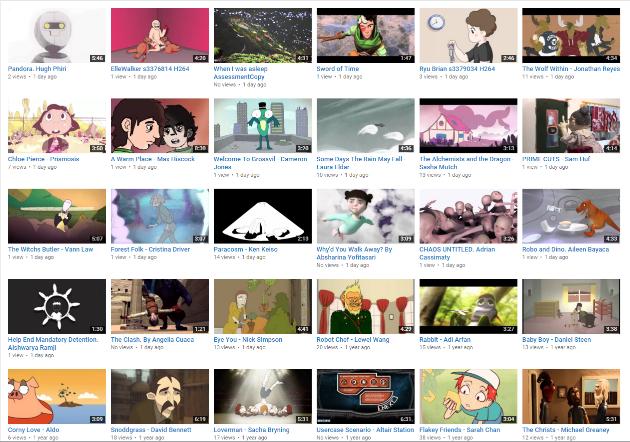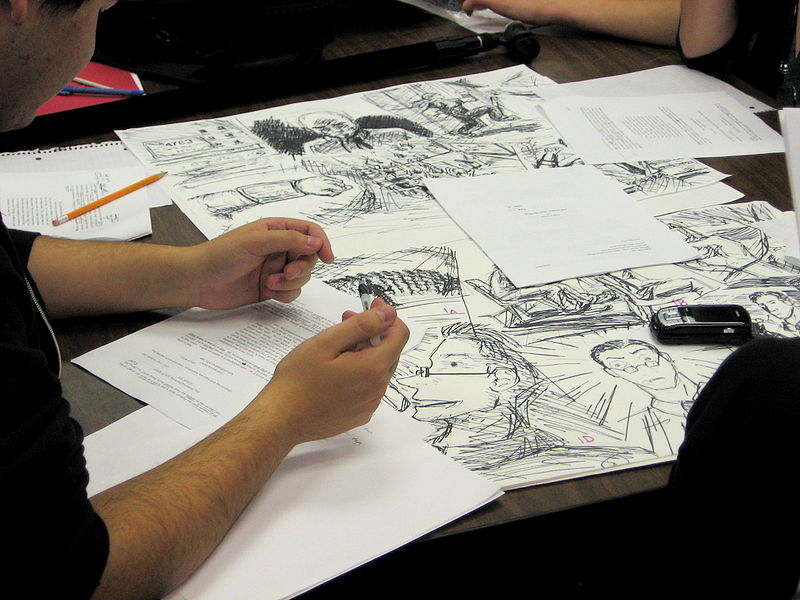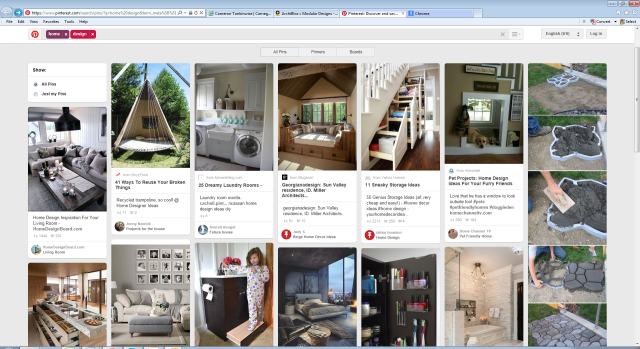Our schedule for posting new articles has been interrupted by illness last week and this week. Rather than fall silent at such times, we aim to find and reproduce the good work of others, and use it to connect to our readership.
The learning management system is always a contentious topic in universities. Andrea McLagan has nominated Michael Fieldstien’s article for redistribution to help our debate along. Michael gives good voice against –or maybe for – the notion of being stuck with our LMS in his article originally posted in November 2014. Here it is on the Teaching TomTom, courtesy of Michael’s use of a creative commons attribution copyright license, in case our readers missed it last year.
Count De Monet: I have come on the most urgent of business. It is said that the people are revolting!
King Louis: You said it; they stink on ice.
– History of the World, Part I
Jonathan Rees discovered a post I wrote about the LMS in 2006 and, in doing so, discovered that I was writing about LMSs in 2006. I used to write about the future of the LMS quite a bit. I hardly ever do anymore, mostly because I find the topic to be equal parts boring and depressing. My views on the LMS haven’t really changed in the last decade. And sadly, LMSs themselves haven’t changed all that much either. At least not in the ways that I care about most. At first I thought the problem was that the technology wasn’t there to do what I wanted to do gracefully and cost-effectively. That excuse doesn’t exist anymore. Then, once the technology arrived as Web 2.0 blossomed, I thought the problem was that there was little competition in the LMS market and therefore little reason for LMS providers to change their platforms. That’s not true anymore either. And yet the pace of change is still glacial. I have reluctantly come to the conclusion that the LMS is the way it is because a critical mass of faculty want it to be that way.
Jonathan seems to think that the LMS will go away soon because faculty can find everything they need on the naked internet. I don’t see that happening any time soon. But the reasons why seem to get lost in the perennial conversations about how the LMS is going to die any day now. As near as I can remember, the LMS has been about to die any day now since at least 2004, which was roughly when I started paying attention to such things.
And so it comes to pass that, with great reluctance, I take up my pen once more to write about the most dismal of topics: the future of the LMS.
In an Ideal World…
I have been complaining about the LMS on the internet for almost as long as there have been people complaining about the LMS on the internet. Here’s something I wrote in 2004:
The analogy I often make with Blackboard is to a classroom where all the seats are bolted to the floor. How the room is arranged matters. If students are going to be having a class discussion, maybe you put the chairs in a circle. If they will be doing groupwork, maybe you put them in groups. If they are doing lab work, you put them around lab tables. A good room set-up can’t make a class succeed by itself, but a bad room set-up can make it fail. If there’s a loud fan drowning out conversation or if the room is so hot that it’s hard to concentrate, you will lose students.
I am a first- or, at most, second-generation internet LMS whiner. And that early post captures an important aspect of my philosophy on all things LMS and LMS-like. I believe that the spaces we create for fostering learning experiences matter, and that one size cannot fit all. Therefore, teachers and students should have a great deal of control in shaping their learning environments. To the degree that it is possible, technology platforms should get out of the way and avoid dictating choices. This is a really hard thing to do well in software, but it is a critical guiding principle for virtual learning environments. It’s also the thread that ran through the 2006 blog post that Jonathan quoted:
Teaching is about trust. If you want your students to take risks, you have to create an environment that is safe for them to do so. A student may be willing to share a poem or a controversial position or an off-the-wall hypothesis with a small group of trusted classmates that s/he wouldn’t feel comfortable sharing with the entire internet-browsing population and having indexed by Google. Forever. Are there times when encouraging students to take risks out in the open is good? Of course! But the tools shouldn’t dictate the choice. The teacher should decide. It’s about academic freedom to choose best practices. A good learning environment should enable faculty to password-protect course content but not require it. Further, it should not favor password-protection, encouraging teachers to explore the spectrum between public and private learning experiences.
Jonathan seems to think that I was supporting the notion of a “walled garden” in that post—probably because the title of the post is “In Defense of Walled Gardens”—but actually I was advocating for the opposite at the platform level. A platform that is a walled garden is one that forces particular settings related to access and privacy on faculty and students. Saying that faculty and students have a right to have private educational conversations when they think those are best for the situation is not at all the same as saying that it’s OK for the platform to dictate decisions about privacy (or, for that matter, that educational conversations should always be private). What I have been trying to say, there and everywhere, is that our technology needs to support and enable the choices that humans need to make for themselves regarding the best conditions for their personal educational needs and contexts.
Regarding the question of whether this end should be accomplished through an “LMS,” I am both agnostic and utilitarian on this front. I can imagine a platform we might call an “LMS” that would have quite a bit of educational value in a broad range of circumstances. It would bear no resemblance to the LMS of 2004 and only passing resemblance to the LMS of 2014. In the Twitfight between Jonathan and Instructure co-founder Brian Whitmer that followed Jonathan’s post, Brian talked about the idea of an LMS as a “hub” or an “aggregator.” These terms are compatible with what my former SUNY colleagues and I were imagining in 2005 and 2006, although we didn’t think of it in those terms. We thought of the heart of it as a “service broker” and referred to the whole thing in which it would live as a “Learning Management Operating System (LMOS).” You can think of the broker as the aggregator and the user-facing portions of the LMOS as the hub that organized the aggregated content and activity for ease-of-use purposes.
By the way, if you leave off requirements that such a thing should be “institution-hosted” and “enterprise,” the notion that an aggregator or hub would be useful in virtual learning environments is not remotely contentious. Jim Groom’s ds106 uses a WordPress-based aggregation system, the current generation of which was built by Alan Levine. Stephen Downes built gRSShopper ages ago. Both of these systems are RSS aggregators at heart. That second post of mine on the LMOS service broker, which gives a concrete example of how such a thing would work, mainly focuses on how much you could do by fully exploiting the rich metadata in an RSS feed and how much more you could do with it if you just added a couple of simple supplemental APIs. And maybe a couple of specialized record types (like iCal, for example) that could be syndicated in feeds similarly to RSS. While my colleagues and I were thinking about the LMOS as an institution-hosted enterprise application, there’s nothing about the service broker that requires it to be so. In fact, if you add some extra bits to support federation, it could just as easily form the backbone of for a distributed network of personal learning environments. And that, in fact, is a pretty good description of the IMS standard in development called Caliper, which is why I am so interested in it. In my recent post about walled gardens from the series that Jonathan mentions in his own post, I tried to spell out how Caliper could enable either a better LMS, a better world without an LMS, or both simultaneously.
Setting aside all the technical gobbledygook, here’s what all this hub/aggregator/broker stuff amounts to:
- Jonathan wants to “have it all,” by which he means full access to the wide world of resources on the internet. Great! Easily done.
- The internet has lots of great stuff but is not organized to make that stuff easy to find or reduce the number of clicks it takes you to see a whole bunch of related stuff. So it would be nice to have the option of organizing the subset of stuff that I need to look at for a class in ways that are convenient for me and make minimal demands on me in terms of forcing me to go out and proactively look to see what has changed in the various places where there might be activity for my class.
- Sometimes the stuff happening in one place on the internet is related to stuff happening in another place in ways that are relevant to my class. For example, if students are writing assignments on their blogs, I might want to see who has gotten the assignment done by the due date and collect all those assignments in one place that’s convenient for me to comment on them and grade them. It would be nice if I had options of not only aggregating but also integrating and correlating course-related information.
- Sometimes I may need special capabilities for teaching my class that are not available on the general internet. For example, I might want to model molecules for chemistry or have a special image viewer with social commenting capabilities for art history. It would be nice if there were easy but relatively rich ways to add custom “apps” that can feed into my aggregator.
- Sometimes it may be appropriate and useful (or even essential) to have private educational conversations and activities. It would be nice to be able to do that when it’s called for and still have access to whole public internet, including the option to hold classes mostly “in public.”
In an ideal world, every class would have its own unique mix of these capabilities based on what’s appropriate for the students, teacher, and subject. Not every class needs all of these capabilities. In fact, there are plenty of teachers who find that their classes don’t need any of them. They do just fine with WordPress. Or a wiki. Or a listserv. Or a rock and a stick. And these are precisely the folks who complain the loudest about what a useless waste the LMS is. It’s a little like an English professor walking into a chemistry lab and grousing, “Who the hell designed this place? You have these giant tables which are bolted to the floor in the middle of the room, making it impossible to have a decent class conversation. And for goodness sake, the tables have gas jets on them. Gas jets! Of all the pointless, useless, preposterous, dangerous things to have in a classroom…! And I don’t even want to knowhow much money the college wasted on installing this garbage.”
Of course, today’s LMS doesn’t look much like what I described in the bullet points above (although I do think the science lab analogy is a reasonable one even for today’s LMS). It’s fair to ask why that is the case. Some of us have been talking about this alternative vision for something that may or may be called an “LMS” for a decade or longer now. And there are folks like Brian Whitmer at LMS companies (and LMS open source projects) saying that they buy into this idea. Why don’t our mainstream platforms look like this yet?
Why We Can’t Have Nice Things
Let’s imagine another world for a moment. Let’s imagine a world in which universities, not vendors, designed and built our online learning environments. Where students and teachers put their heads together to design the perfect system. What wonders would they come up with? What would they build?
Why, they would build an LMS. They did build an LMS. Blackboard started as a system designed by a professor and a TA at Cornell University. Desire2Learn (a.k.a. Brightspace) was designed by a student at the University of Waterloo. Moodle was the project of a graduate student at Curtin University in Australia. Sakai was built by a consortium of universities. WebCT was started at the University of British Columbia. ANGEL at Indiana University.
OK, those are all ancient history. Suppose that now, after the consumer web revolution, you were to get a couple of super-bright young graduate students who hate their school’s LMS to go on a road trip, talk to a whole bunch of teachers and students at different schools, and design a modern learning platform from the ground up using Agile and Lean methodologies. What would they build?
They would build Instructure Canvas. They did build Instructure Canvas. Presumably because that’s what the people they spoke to asked them to build.
In fairness, Canvas isn’t only a traditional LMS with a better user experience. It has a few twists. For example, from the very beginning, you could make your course 100% open in Canvas. If you want to teach out on the internet, undisguised and naked, making your Canvas course site just one class resource of many on the open web, you can. And we all know what happened because of that. Faculty everywhere began opening up their classes. It was sunlight and fresh air for everyone! No more walled gardens for us, no sirree Bob.
That is how it went, isn’t it?
Isn’t it?
I asked Brian Whitmer the percentage of courses on Canvas that faculty have made completely open. He didn’t have an exact number handy but said that it’s “really low.” Apparently, lots of faculty still like their gardens walled. Today, in 2014.
Canvas was a runaway hit from the start, but not because of its openness. Do you know what did it? Do you know what single set of capabilities, more than any other, catapulted it to the top of the charts, enabling it to surpass D2L in market share in just a few years? Do you know what the feature set was that had faculty from Albany to Anaheim falling to their knees, tears of joy streaming down their faces, and proclaiming with cracking, emotion-laden voices, “Finally, an LMS company that understands me!”?
It was Speed Grader. Ask anyone who has been involved in an LMS selection process, particularly during those first few years of Canvas sales.
Here’s the hard truth: While Jonathan wants to think of the LMS as “training wheels” for the internet (like AOL was), there is overwhelming evidence that lots of faculty want those training wheels. They ask for them. And when given a chance to take the training wheels off, they usually don’t.
Let’s take another example: roles and permissions. Audrey Watters recently called out inflexible roles in educational software (including but not limited to LMSs) as problematic:
Ed-tech works like this: you sign up for a service and you’re flagged as either “teacher” or “student” or “admin.” Depending on that role, you have different “privileges” — that’s an important word, because it doesn’t simply imply what you can and cannot do with the software. It’s a nod to political power, social power as well.
Access privileges in software are designed to enforce particular ways of working together, which can be good if and only if everybody agrees that the ways of working together that the access privileges are enforcing are the best and most productive for the tasks at hand. There is no such thing as “everybody agrees” on something like the one single best way for people to work together in all classes. If the access privileges (a.k.a. “roles and permissions”) are not adaptable to the local needs, if there is no rational and self-evident reason for them to be structured the way they are, then they end up just reinforcing the crudest caricatures of classroom power relationships rather than facilitating productive cooperation. Therefore, standard roles and permissions often do more harm than good in educational software. I complained about this problem in 2005 when writing about the LMOS and again in 2006 when reviewing an open source LMS from the UK called Bodington. (At the time, Stephen Downes mocked me for thinking that this was an important aspect of LMS design to consider.)
Bodington had radically open permissions structures. You could attach any permissions (read, write, etc.) to any object in the system, making individual documents, discussions, folders, and what have you totally public, totally private, or somewhere in between.You could collect sets of permissions and and define them as any roles that you wanted. Bodington also, by the way, had no notion of a “course.” It used a geographical metaphor. You would have a “building” or a “floor” that could house a course, a club, a working group, or anything else. In this way, it was significantly more flexible than any LMS I had seen before.
Of course, I’m sure you’ve all heard of Bodington, its enormous success in the market, and how influential it’s been on LMS design.
What’s that? You haven’t?
Huh.
OK, but surely you’re aware of D2L’s major improvements in the same area. If you recall your LMS patent infringement history, then you’ll remember that roles and permissions were exactly the thing that Blackboard sued D2L over. The essence of the patent was this: Blackboard claimed to have invented a system where the same person could be given the role of “instructor” in one course site and the role of “student” in another. That’s it. And while Blackboard eventually lost that fight, there was a court ruling in the middle in which D2L was found to have infringed on the patent. In order to get around it, the company ripped out its predefined roles, making it possible (and necessary) for every school to create its own. As many as they want. Defined however they want. I remember Ken Chapman telling me that, even though it was the patent suit that pushed him to think this way, in the end he felt that the new way was a significant improvement over the old way of doing things.
And the rest, as you know, was history. The Chronicle and Inside Higher Ed wrote pieces describing the revolution on campuses as masses of faculty demanded flexible roles and permissions. Soon it caught the attention of Thomas Friedman, who proclaimed it to be more evidence that the world is indeed flat. And the LMS market has never been the same since.
That is what happened…right?
No?
Do you want to know why the LMS has barely evolved at all over the last twenty years and will probably barely evolve at all over the next twenty years? It’s not because the terrible, horrible, no-good LMS vendors are trying to suck the blood out of the poor universities. It’s not because the terrible, horrible, no-good university administrators are trying to build a panopticon in which they can oppress the faculty. The reason that we get more of the same year after year is that, year after year, when faculty are given an opportunity to ask for what they want, they ask for more of the same. It’s because every LMS review process I have ever seen goes something like this:
- Professor John proclaims that he spent the last five years figuring out how to get his Blackboard course the way he likes it and, dammit, he is not moving to another LMS unless it works exactly the same as Blackboard.
- Professor Jane says that she hates Blackboard, would never use it, runs her own Moodle installation for her classes off her computer at home, and will not move to another LMS unless it works exactly the same as Moodle.
- Professor Pat doesn’t have strong opinions about any one LMS over the others except that there are three features in Canvas that must be in whatever platform they choose.
- The selection committee declares that whatever LMS the university chooses next must work exactly like Blackboard and exactly like Moodle while having all the features of Canvas. Oh, and it must be “innovative” and “next-generation” too, because we’re sick of LMSs that all look and work the same.
Nobody comes to the table with an affirmative vision of what an online learning environment should look like or how it should work. Instead, they come with this year’s checklists, which are derived from last year’s checklists. Rather than coming with ideas of what they could have, the come with their fears of what they might lose. When LMS vendors or open source projects invent some innovative new feature, that feature gets added to next year’s checklist if it avoids disrupting the rest of the way the system works and mostly gets ignored or rejected to the degree that it enables (or, heaven forbid, requires) substantial change in current classroom practices.
This is why we can’t have nice things. I understand that it is more emotionally satisfying to rail against the Powers That Be and ascribe the things that we don’t like about ed tech to capitalism and authoritarianism and other nasty isms. And in some cases there is merit to those accusations. But if we were really honest with ourselves and looked at the details of what’s actually happening, we’d be forced to admit that the “ism” most immediately responsible for crappy, harmful ed tech products is consumerism. It’s what we ask for and how we ask for it. As with our democracy, we get the ed tech that we deserve.
In fairness to faculty, they don’t always get an opportunity to ask good questions. For example, at Colorado State University, where Jonathan works, the administrators, in their infinite wisdom, have decided that the best course of action is to choose their next LMS for their faculty by joining the Unizin coalition. But that is not the norm. In most places, faculty do have input but don’t insist on a process that leads to a more thoughtful discussion than compiling a long list of feature demands. If you want agitate for better ed tech, then changing the process by which your campus evaluates educational technology is the best place to start.
There. I did it. I wrote the damned “future of the LMS” post. And I did it mostly by copying and pasting from posts I wrote 10 years ago. I am now going to go pour myself a drink. Somebody please wake me again in another decade.










